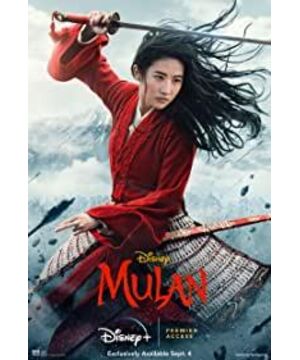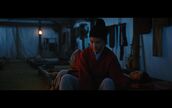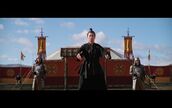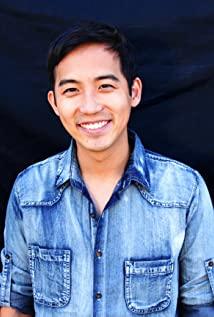[This article was published in the 6th issue of "Film Art" in 2020]
The 2020 version of "Mulan" has sparked unprecedented controversy as a reverse cultural product, and the public opinion circles have been arguing about "cultural export" or "cultural appropriation". This makes us have to seriously examine the cultural symptom, the role of the source culture film as an interface, is it a filtering device or an oppressive device? Here, we might as well use the four key words of "loyalty, bravery, truthfulness, and filial piety" to enrich the review of the film. Of course, this review is no longer based on the literal meaning, but on faithfulness (in terms of adaptation) and courage (in terms of topic). words), authenticity (in terms of historical facts), and filial piety (in terms of cognition), perhaps through these four reinterpreted keywords, we can provide different perspectives and clues for the reinterpretation of "Mulan".
Loyalty: Front, Back and Displacement
There is a saying in the media that the 2020 version of Mulan is the most faithful adaptation of the original work, which not only presents the allusion of "two rabbits walking next to the ground" in "Mulan Ci", but also embodies the shape of "mirror decals in yellow". But the order of the two passages is different from the original.
Especially in the original poem, "When the window is on the temples, and the mirror is yellow with yellow decals" is Mulan's actions after ten years of return. In the movie, it is pre-positioned as Mulan's actions before joining the army, and the plot of a blind date with a prejudiced matchmaker is arranged, which is narrated. Functionally, it is to emphasize the decadent cultural tradition that "a woman's lack of talent is a virtue". But at the end of the film, the scene of "Ce Xun 12 turns, rewarding a hundred thousand strong" (the sword bestowed by the emperor is passed to Mulan) is left behind, as if to highlight the glory of returning home. However, the changes in these two orders greatly affected the direction of the plot and also changed the structure of the signifier chain.
Mulan in the original poem is a chain of signifiers from family labor (Weaver Girl) → war generals → housewives, but in the movie it becomes a chain of worry-free girls → women to be married → warriors → female warriors, this new signifier chain There is even a potential end point, a "master signifier" in the Lacanian sense[1], that is, Mulan has been promoted to Disney's princess sequence. The main signifier is "a signifier that can represent other signifiers", but because Hua Mulan has neither the blood of the royal family nor married into the royal family, then this kind of "jinfeng" (main signifier transformation) naturally requires a grand Ceremony to support: In the 1998 animated version, the emperor and ten thousand people knelt to achieve it; in the 2020 live-action version, the word "filial piety" is engraved on the sword bestowed by the emperor, which seems to have a special meaning.
We can even extend this signifier chain in this way: the father's sword was destroyed, and now it has been replaced by the emperor's sword, then the signifier of "filial piety" no longer corresponds to the original father, but the current emperor. It symbolizes that Mulan is crowned as a princess in disguise, and it also points to the displacement or unity of power. It is worth mentioning that "filial piety" here is translated as "devotion to family", not "filial piety" in the traditional sense. The character and story of Hua Mulan are fundamentally different from ours, so it is impossible to say that they are loyal to the original work.
There is another scene in the film that is misplaced, that is, "The male rabbit's feet flutter, the female rabbit's eyes are blurred; the two rabbits walk next to the ground, An Neng can tell whether I am male or female?" This sentence is an epigram or summary in the original poem. The word, which belongs to the explanatory composition of the voice-over, is inserted as a signifier into the opening field outing paragraph in the film, as if to imply that Mulan will face gender obstacles or problems. This misplaced "flash forward" acts as a The lead of the play is no longer the finishing touch, which means that the legend of Mulan has a hidden guide - this guide is no longer an opportunity to recruit troops, but is answered by the "Chi" in her body .
The purpose of misplacement of paragraphs is to relate the concept, function and purpose of "Qi", which is the most important thing hidden in Hua Mulan's body, more crucial than her daughter's body, because this is not something normal people have, but a kind of Western-style "miracles", a kind of "calling", an unnatural element of witch attributes, and a power source for the transformation of characters' actions, so "qi" has become another main signifier in the film. [2] It is not difficult for the audience to match the "Qi" here with the "Force" in the "Star Wars" series, and several characters in the film have a tug-of-war around "Qi": Mulan's father asks to hide her "qi", while Gong Li's fairy godmother asks Mulan to release her "qi".
But "Qi" has always been an element that did not exist in the original work. Here it has not only become a rigidly inserted main signifier, but also Lacan's Pheleus signifier. Whether to castrate or retain "Qi" has become a pendulum. Multiple-choice questions in front of Mulan. This choice is like "Who I am inside" and "Who I am outside" in the lyrics of the movie's theme song. When Hua Mulan stared at the reflection in the sword, she realized and chose the former, releasing her "qi", Returning to the battlefield as a red-clothed and angry horse, at this time, her upper body is red and the lower body is armored, and her long hair is fluttering. There is no doubt that Disney has changed the signifier chain in the original "Mulan Ci" through the preposition, postposition and dislocation of paragraphs, changing the character attributes, and transforming Hua Mulan from a Chinese legendary hero into the world. Disney princesses in sexual fairy tales.
Courage: The Logic of Identity Cognition
In a passage in the film, several warriors discuss their ideal woman, and Mulan's answer is: "Brave, humorous, intelligent." This statement was taken as a joke by her companions, because it did not describe a woman woman. But at the signifier level, this sentence is especially true. The person Mulan said was herself; when Mulan changed back to the red dress, she became that herself.
That's why the Chinese version of " Reflection ", the theme song of "Mulan" , is "Self", which subtly infuses the relationship between mirroring and narcissism, and her sword is presented as a mirror, which is also Lacan Meaning "mirror". Before she became a real female warrior, she always knew herself by the identity of others: the other as a father, the other as a man, the other as a soldier, the other as a witch. self-awareness is rather vague. For this reason, she had to hide under her father's armor, hide under the attire of men, and hide her "chi". The revealing of the identity is often the key to the narrative. For this reason, many film and television versions will arrange a "bath scene" to create a threat. In the 1998 animation version, Mulan's identity is passively presented (discovered by the doctor), while in 2020 The version is that she voluntarily confessed.
From passive discovery to active disclosure, the difference is seen as "courage," or progress in feminist self-awareness. But there are some complicated influencing factors. For example, Mulan's entire story narrative is told through the perspective of her father (voice-over), which means that the "father's name" still dominates the narrative; the second is the moment when Mulan confesses her identity. It was a critical juncture, and the pressure of the situation reduced her initiative. Although she is active in the pursuit of gender politics, the narrative aspect of the film is limited. For example, the relationship between Hua Mulan and Chen Honghui is not pure love, but seems to be between a lover and a best friend; at the same time, she can't have a relationship with her boss, General Dong. Having a romantic relationship is generally seen as a politically correct change by Hollywood screenwriters under the Me Too movement (it can also be seen as a form of cowardice). However, it should be noted that when General Dong admired Mulan and said that he would marry her daughter, Mulan actually showed joy from the heart. This joy may come from her being recognized as an excellent fighter, but it still gives people weirdness a feeling of.
This feeling finally manifests in the strange relationship between Mulan and Xianniang. Unlike Mulan's daughter who is suppressed in men's clothes, Xianniang's masculine and fierce side is trapped in the female body (she can also be regarded as A radical homosexual), her inside and outside are precisely Mulan's inversions, and thus can be seen as Mulan's reverse double. [3] What they have in common is not only the reversal of the inner and outer shapes of men and women, but also the vague setting between human and monster. Because of the introduction of the concept of "Qi", the fairy can be transformed into an eagle, and Mulan can summon a phoenix. At this peculiar level of being different from human beings, the two seem to develop a secret, unspeakable attachment between them.
Male/female, heterosexual/gay/narcissistic, human/witch, these split identities are all haunting Mulan. In fact, Disney superimposed multiple layers of mirror puzzles on this person to reinforce her brave side. In this regard, the selection of Liu Yifei to play is also based on the same logic: Liu Yifei was known for playing beauties in ancient costumes in his early years, and was known as "the fairy sister". The immortal sister refers to a negative image of world-weary and refined, but a heroine like Hua Mulan is a positive image of joining the WTO. There is a large contrast between the two, which is conducive to the breakthrough of the characters. Therefore, when Mulan takes the initiative to reveal her identity and return to being a woman, even if she still has a little androgynous shape, it can still give the audience a great impact and sense of identity. After this kind of dress-up, there is also a flipping movement in the air, like the dance of a fairy, which reproduces a fresh and refined.
This kind of impact comes from the double main signifier, one is the female blooming as a Disney princess, that is, the bravery, humor, and cleverness she mentioned, which is the standard of the West; the other is the return to the elegance of the Chinese-style fairy sister Refined, this is the standard of the East. These two personalities are the main signifiers of their respective "ideal women" in Western and Eastern cultures, but Disney has the ability to blend them together. But its premise is the confusion of many identities mentioned earlier. This confusion can be seen as a wrestling and struggle between two main signifiers. In this text that occurred in the East and made in the West, there was always the question of which main signifier took precedence, and this question was first resolved through a kind of cartography. Express.
True: From Cartography to Geography
The most criticized part of "Mulan" is its false geography. For example, the Fujian Tulou appeared in the north, the New Zealand grassland snow-capped mountains appeared in China, and there were also outdated lanterns, couplets, modern calligraphy, geisha costumes and other elements. But in the final analysis, this is not illogical, but just illogical (Chinese logic, historical logic), it belongs to a typical Hollywood mapping (mapping): providing a "world-building" (world-building) , this world structure only needs to provide a "feel" of the Chinese region, which can help global audiences understand this space and shape the characters associated with it. [4]
This kind of cartography has a clear model in reality, that is, Chinatown - Chinatown is the geography in reality, but not the geography of China, but the imaginary geography constructed by the Chinese overseas, where the imaginary symbols of China for five thousand years Being collaged together, they no longer distinguish between east, west, north, south and chronological history, but are heterogeneously integrated into a kind of nostalgic geography. Walking in Chinatown, foreigners have the feeling of stepping into China, and Chinese people have a familiar sense of relaxation. The reason why this imagined geography can be harmoniously formed comes from the greater heterogeneity of the external cultural surround.
Expanding this geography, we will find that Chinatown is surrounded by the external Western world, while China is surrounded by Western-led globalization, and cartography derived from cultural encirclement has become a symptom of the times. This symptom also led to Hollywood's dominance of cartography in film production, and Hollywood's cartography became the main signifier, while the real Chinese geography became the represented signifier. This subversion of the signifier is what Baudrillard calls the "precession of simulacra"[5]—in the past, maps were drawn according to actual regions, but now regions are represented according to maps. As a result, the geography that appears in films such as "Mulan" can't find the corresponding territory in reality. This situation is not only unique to China, such as France ("Beauty and the Beast"), Mexico ("Dream Travel") , Northern Europe ("Frozen"), and the Arab world ("Aladdin") were not spared.
What's more, in live-action shooting, site selection and setting have magnified the drawbacks of this map technique (after all, its degree of freedom is not as good as animation). But even so, "Mulan" still tries to maintain a kind of internal consistency of geography: when the 1998 version of "Mulan" was produced, Disney used more than 600 animators to visit Beijing, Datong, Xi'an, Luoyang, Dunhuang, etc. Cultural city, visit museums, art galleries, and even visit Jiayuguan Great Wall in person, and collect a lot of information. This attitude of pursuing truth is naturally good, but they also fall into another misunderstanding: Chinese historical art, especially sculpture and painting, is not realistic art in the Western paradigm at all. There is no direct reference for photographic modeling, otherwise there will be an exaggerated painting style such as "yellow makeup".
Therefore, the sense of authenticity should be a relative issue. After all, the domestic Hua Mulan film and television works cannot stand up to scrutiny in the details, not to mention that Mulan herself and her stories cannot be tested, which also leaves a greater degree of freedom for story writing. Therefore, Disney uses cartography to create a "fantasy geography", an inner unified world where Western audiences can't see the gang, and there is no moral problem, not to mention that they have removed the iconic musical style and Such a popular magic-modified character as Mushulong is already an improvement in itself. However, this kind of progress cannot be complete. The existence of interculturality means that the confrontation between "map" and "real geography" cannot be eliminated, and the main signifier status of "mapping" can hardly be erased.
In addition to the Chinatown mentioned above, the museum is naturally another reference standard for Hollywood cartography. For the latter, it seems more appropriate to link the cultural collage in "Mulan" to the " China: Through the Looking Glass " exhibition at the Metropolitan Museum of Art in 2015. This is the most popular and most talked about China-themed exhibition in history, but it is still a mess, for which the organizer even made a modest guide statement: "This exhibition is not about China itself, but is a series of fantasies about China. It proposes to explore the aesthetic importance of all cultural imaginations. It is not our concern whether these works represent the reality of the 'other' culture. On the contrary, we hope to study these representations themselves. , appreciate their independent creativity.”[6]
The strong economic and cultural advantages of the Western world make the symptoms of cartography unavoidable, but the appearance of the Lacanian keyword Looking Glass here also means that it is the lingering ghost behind cultural export and cultural appropriation. , "Mulan", like "China: Through the Looking Glass", has become an interface between Eastern and Western cultures, a mirror of psychoanalysis. As Wong Kar-wai, the artistic director of "China: Through the Looking Glass" said: "The moon from the East is thrown into the water mirror of the West, and what appears is not necessarily reality, but a different aesthetic."[7] Wong Kar-wai said it More like a window, but actually more like an imaginary map, a map that represents the original geography. This representation is no longer a "reproduction", but a "re-make" at all.
Filial Piety: Disney and Homeland Imagination
Of the four keywords of loyalty, courage, truth and filial piety mentioned in the film, the first three characters are engraved on Mulan's father's sword, while the word "filial piety" is engraved on the Phoenix family emblem alone. At the beginning, they were in a symbolic state of division, that is, loyalty, bravery, and true country symbols are the attributes of warriors; while "filial piety" is a symbol of family and the attributes of being a family member.
Disney is so keen to manipulate Chinese cultural symbols this time. In addition to the false fanaticism caused by market reasons, it also played a word game in disguise: Hua Mulan, as a Disney princess, is the person who finally unites the four virtues of loyalty, bravery and filial piety. , this is the last sword given by the emperor: loyalty, bravery and filial piety are engraved on the same sword, and it is a sword blessed by the highest power. There are two meanings in this kind of text: one is to symbolize the completion of the consciousness of integration of family and country in Chinese culture, and the other is that "filial piety" has been raised to a high position ambiguous, even surpassing the other three keywords Above - This used to be the foundation of Confucian culture, but now it has become the foundation of Disney's world domination.
Why do you say that? We can refer to the above-mentioned, "filial piety" is translated as "devotion to family" instead of "filial piety", the logical starting point is to replace the traditional Chinese "family" with the Western-style "family", then who is in the What about "devotion to family"? In reality, it's the Disney company itself that is firmly committed to this purpose, and the company has been committed to creating a genre of movies for nearly a hundred years: "Family movies." Therefore, "filial piety" is easy to understand as the subject. Its function is to realize a kind of concept stealing with the help of Chinese and English conversion skills, thereby potentially stitching together Chinese filial piety and Disney's imperial fantasy.
This method is absolutely brilliant, and it also means that Disney does not understand Chinese culture, nor is it that they have no intention to engage in Chinese culture seriously, but they are more interested in the "use" of Chinese culture, and their capital IQ has always been maintained at a very high level. dimension. For this reason, Disney does not pay much attention to whether the adaptation, characters, and geography conform to the source text, but pays attention to the family ticket warehouse on a global scale[8]-for this reason, they collect various princess themes all over the world and assimilate them into Its own products have formed a "Princess Home", and it is also a traffic home similar to the Avengers. Compared with the characters of the subsidiary Marvel, Disney's Princess IP is more attractive to family customers. force.
Hua Mulan became a Disney princess and accepted the sword from the "emperor", which also made it easy for people to associate the Chinese imperial power with Disney's capitalist empire. Ni Zhange believes that the one who gave Mulan the sword in the film is what fans dubbed "Dad Di", and the logic thus becomes "As long as you are loyal to yourself, you can support your family and defend my capital empire." [9] According to this view, China in the film corresponds to the Disney capital empire and can be replaced by any other culture, and these cultures will eventually be collected and requisitioned by the capital empire. Disney princesses all over the world is a proof. Filling up Disney's databases and vaults. After peeling off this layer of skin, we can see that Disney's so-called progress is nothing more than a "disguise". It is definitely a model of commercial success, but never a model of "foreign culture as a method".
references
[1] For the meaning and operation mechanism of the main signifier, see Wu Qiong, "Jacques Lacan: Reading Your Symptoms", Renmin University of China Press, 2011, p. 354.
[2] Disney has many transcendental laws similar to "chi", such as Cinderella's glass slipper, or Elsa's magic in "Frozen", etc.
[3] It is worth noting that there is only a thin line between Mulan and Xianniang, but the difference between Hua Mulan is that she has the setting of a Disney princess, so she can transcend the latter's identity limitations and be forgotten, which is also the tradition of Western culture. In Western fantasy history, princesses are often the only figures who have the legal right to use magic.
[4] For the performance of cartography in cultural works, see Chang Shi, Cartography: From Fantasy Literature to Story World, Literary Studies, No. 2, 2019, pp. 48-59.
[5] Jean Baudrillard, Simulacra and Simulation , University of Michigan Press, 1994, p.1.
[6] Wang Xiaonan, Film, Fashion and Chinese Imagination - Taking the Metropolitan Museum's "China: Through the Looking Glass Special Exhibition" as an example, "Henan Social Sciences", November 2015, Vol. 23, No. 11, pp. 101-105 .
[7] Ibid.
[8] Similarly, changing "Mulan" to pay-for-demand on the Disney+ network is also a form of broadcasting that focuses on and attracts family tourists.
[9] See "Mulan" (2020) Four-person talk: The ever-changing Mulan, the "true self" style, and Disney's "Home Country World", Baoma Public Account, September 16, 2020.
View more about Mulan reviews











